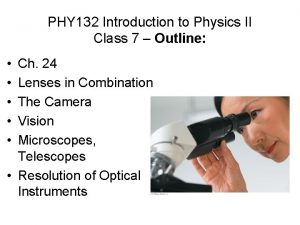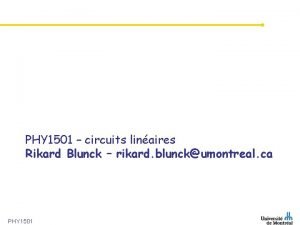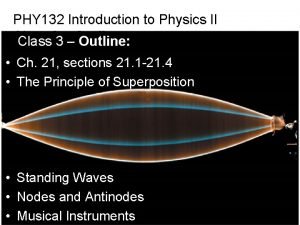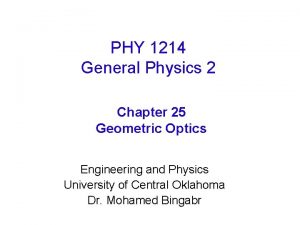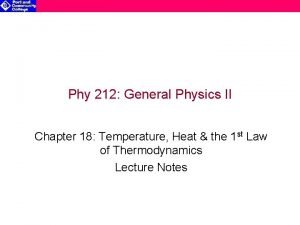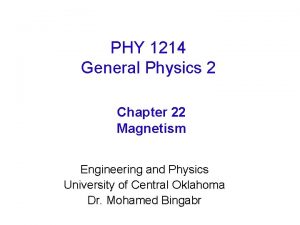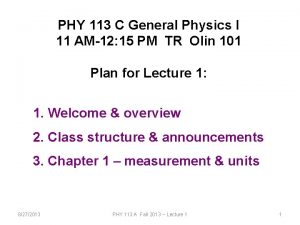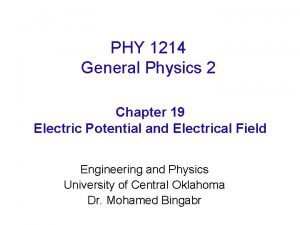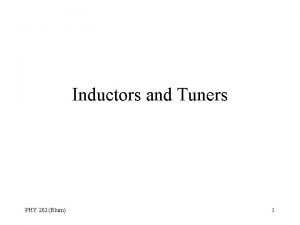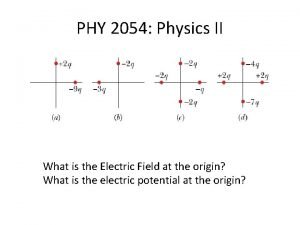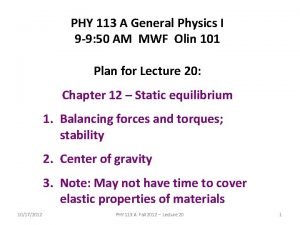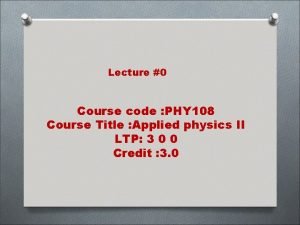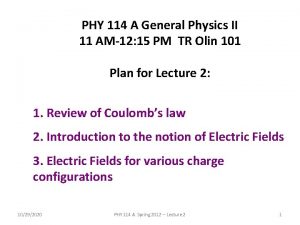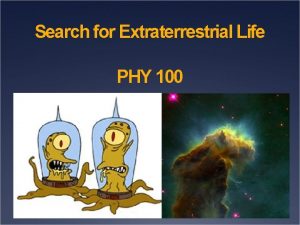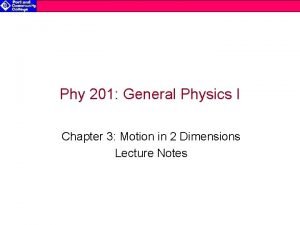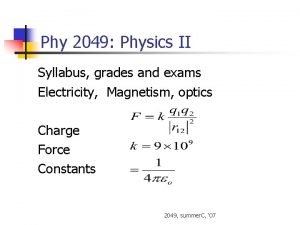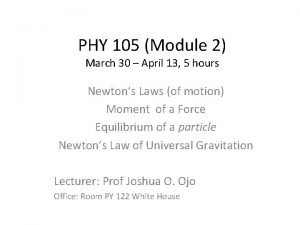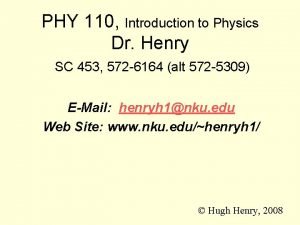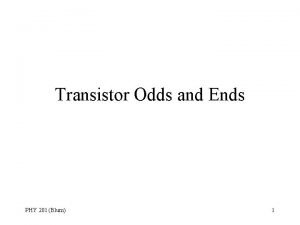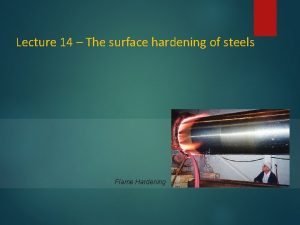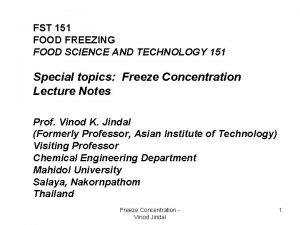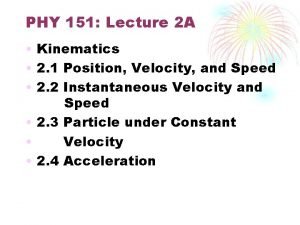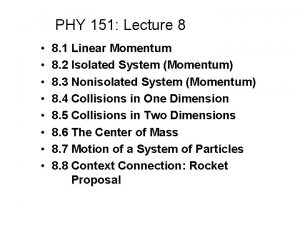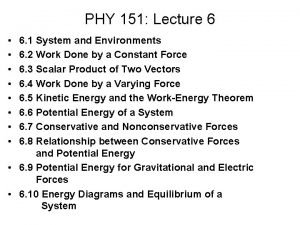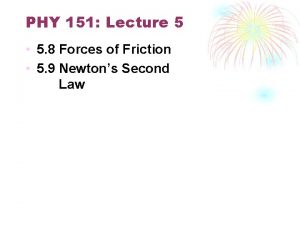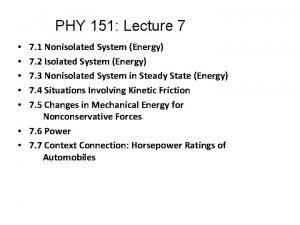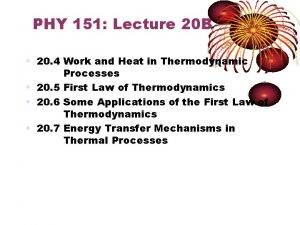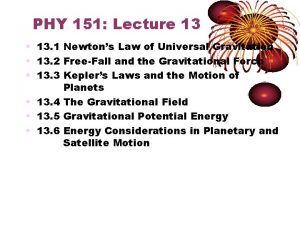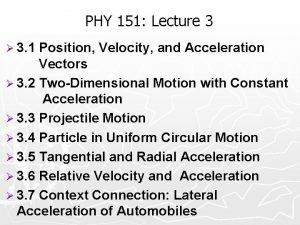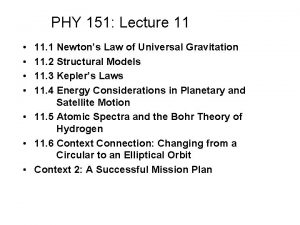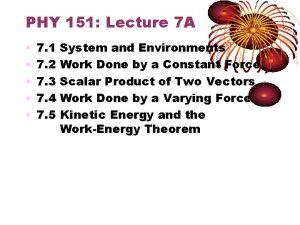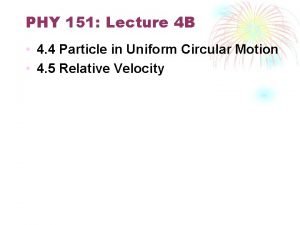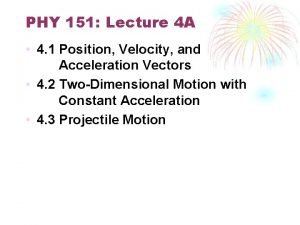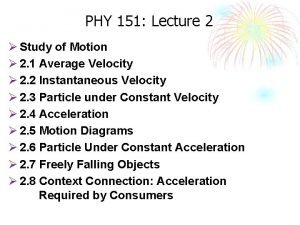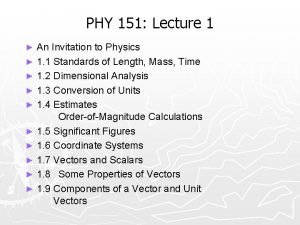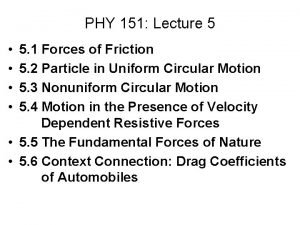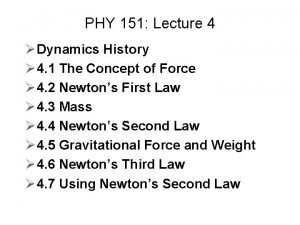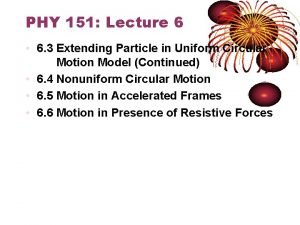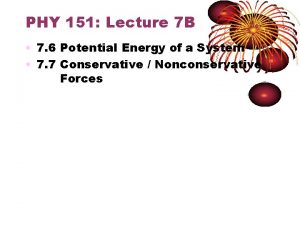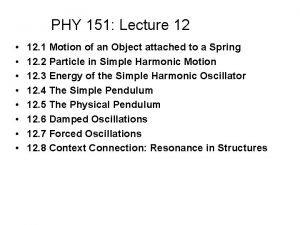PHY 151 Lecture 20 A 20 1 Heat








































- Slides: 40

PHY 151: Lecture 20 A • 20. 1 Heat and Internal Energy • 20. 2 Specific Heat and Calorimetry • 20. 3 Latent Heat

PHY 151: Lecture 20 A First Law of Thermodynamics 20. 1 Heat and Internal Energy

Thermodynamics – Historical Background • Thermodynamics and mechanics were considered to be distinct branches of physics – Until about 1850 – Experiments by James Joule and others showed a connection between them • A connection was found between the transfer of energy by heat in thermal processes and the transfer of energy by work in mechanical processes • The concept of energy was generalized to include internal energy • The principle of conservation of energy emerged as a universal law of nature

Thermodynamics – Chapter Overview • Will discuss internal energy, the first law of thermodynamics, and applications of the first law • The first law of thermodynamics describes systems in which the only energy change is that of internal energy • The transfers of energy are by heat and work • Will consider work done on deformable systems

Internal Energy • Internal energy is all the energy of a system that is associated with its microscopic components – These components are its atoms and molecules – The system is viewed from a reference frame at rest with respect to the center of mass of the system

Internal Energy and Other Energies • The kinetic energy due to its motion through space is not included • Internal energy does include kinetic energies due to: – Random translational motion – Rotational motion – Vibrational motion • Internal energy also includes potential energy between molecules

Heat • Heat is defined as the transfer of energy across the boundary of a system due to a temperature difference between the system and its surroundings • The term heat will also be used to represent the amount of energy transferred by this method • There are many common phrases that use the word “heat” incorrectly • Heat, internal energy, and temperature all different quantities – Be sure to use the correct definition of heat – You cannot talk about the “heat of a system, ” you can refer to heat only when energy has been transferred as a result of a temperature difference

Units of Heat • Historically, the calorie was the unit used for heat – One calorie is the amount of energy transfer necessary to raise the temperature of 1 g of water from 14. 5 o. C to 15. 5 o. C • The “Calorie” used for food is actually 1 kilocalorie • In the US Customary system, the unit is a BTU (British Thermal Unit) – One BTU is the amount of energy transfer necessary to raise the temperature of 1 lb of water from 63 o. F to 64 o. F • The standard in the text is to use Joules

James Prescott Joule • 1818 – 1889 • British physicist • Largely self-educated – Some formal education from John Dalton • Research led to establishment of the principle of conservation of energy • Determined the amount of work needed to produce one unit of energy

Mechanical Equivalent of Heat - 1 • Joule established the equivalence between mechanical energy and internal energy • His experimental setup is shown at right • The decrease in potential energy associated of the system as the blocks fall equals the work done by the paddle wheel on the water

Mechanical Equivalent of Heat - 2 • Joule found that it took approximately 4. 18 J of mechanical energy to raise the water 1 o. C • Later, more precise, measurements determined the amount of mechanical energy needed to raise the temperature of water from 14. 5 o. C to 15. 5 o. C • 1 cal = 4. 186 J – This is known as the mechanical equivalent of heat • A more proper name would be the equivalence between mechanical energy and internal energy, but the historical name is well entrenched

Mechanical Equivalent of Heat Example • A student eats a dinner rated at 2000 Calories • He wishes to do an equivalent amount of work in the gymnasium by lifting a 50. 0 kg barbell • How many times must he raise the barbell to expend this energy • Assume he raises the barbell 2. 00 m each time he lifts it and he regains no energy when he lowers the barbell Ø DUtotal = Wtotal Ø DU = mgh Ø DUtotal = nmgh (n is the number of lifts) Ø nmgh = Wtotal Ø n = Wtotal / mgh Ø n = [(2000 Cal)/(50. 0 kg)(9. 80)(2. 00)](1. 00 x 103 cal/Cal)(4. 186 J/1 cal) Ø n = 8. 54 x 103 times

PHY 151: Lecture 20 A First Law of Thermodynamics 20. 2 Specific Heat and Calorimetry

Heat Capacity • The heat capacity, C, of a particular sample is defined as the amount of energy needed to raise the temperature of that sample by 1 o. C • If energy Q produces a change of temperature of DT, then Q = C DT

Specific Heat • Specific heat, c, is the heat capacity per unit mass • If energy Q transfers to a sample of a substance of mass m and the temperature changes by DT, then the specific heat is • The specific heat is essentially a measure of how thermally insensitive a substance is to the addition of energy – The greater the substance’s specific heat, the more energy that must be added to a given mass to cause a particular temperature change • The equation is often written in terms of Q : Q = m c DT

Some Specific Heat Values

Internal Energy Revisited • The change in internal energy of a system can be identified with m c Δ t – If we ignore any thermal expansion or contraction of the system • Then ΔEint = Q • The internal energy of a system can be changed by transferring energy into the system by any mechanism – This also indicates temperature is related to the energy of the molecules of a system

Specific Heat Varies With Temperature • Technically, the specific heat varies with temperature • The corrected equation is • However, if the temperature intervals are not too large, the variation can be ignored and c can be treated as a constant – For example, for water there is only about a 1% variation between 0 o and 100 o. C – These variations will be neglected unless otherwise stated

Specific Heat of Water • Water has the highest specific heat of common materials • This is in part responsible for many weather phenomena: – Moderate climates near large bodies of water – Global wind systems – Land sea breezes

Calorimetry • One technique for measuring specific heat involves heating a material, adding it to a sample of water, and recording the final temperature • This technique is known as calorimetry – A calorimeter is a device in which this energy transfer takes place • The system of the sample and the water is isolated • Conservation of energy requires that the amount of energy that leaves the sample equals the amount of energy that enters the water – Conservation of Energy gives a mathematical expression of this: Ø Qcold= -Qhot

Sign Conventions • If the temperature increases: ØQ and DT are positive – Energy transfers into the system • If the temperature decreases: ØQ and DT are negative – Energy transfers out of the system • The negative sign in the calorimetry equation is critical for consistency with the sign convention

Calorimetry, final • Tf is the final temperature after the system comes to equilibrium • The subscript w represent values for water and x represents the values for the sample whose specific heat is to be determined • Since each Q = mc. DT, the calorimetry equation can be expressed as – This can be solved for the unknown specific heat – Technically, the mass of the container should be included, but if mw >>mcontainer it can be neglected

Calorimetry, Example - 1 • A 0. 050 kg ingot of metal is heated to 200. 0 0 C and then dropped into a calorimeter containing 0. 400 kg of water initially at 20. 0 0 C. The final equilibrium temperature of the mixed system is 22. 4 0 C. Find the specific heat of the metal • mwcw(Tf - Tw) = -mxcx(Tf - Tx)

Calorimetry, Example - 2 • A cowboy fires a silver bullet with a muzzle speed of 200 m/s into the pine wall of a saloon. Assume all the internal energy generated by the impact remains with the bullet. What is the temperature change of the bullet? • DK + DEint = 0 • DEint = mc. DT • (0 – ½ mv 2) + mc. DT = 0 • DT = ½ mv 2/mc = v 2/2 c = (200)2/2(234) = 85. 5 0 c

PHY 151: Lecture 20 A First Law of Thermodynamics 20. 3 Latent Heat

Phase Changes • A phase change is when a substance changes from one form to another – Two common phase changes are • Solid to liquid (melting) • Liquid to gas (boiling) • During a phase change, there is no change in temperature of the substance – For example, in boiling the increase in internal energy is represented by the breaking of the bonds between molecules, giving the molecules of the gas a higher intermolecular potential energy

Latent Heat - 1 • Different substances react differently to the energy added or removed during a phase change – Due to their different internal molecular arrangements • The amount of energy also depends on the mass of the sample – The higher-phase material is the material existing at the higher temperature. • Example, water is the higher-phase material in an ice-water mixture – The initial amount of the higher-phase material in a system is mi • If an amount of energy Q is required to change the phase of a sample is • L ≡ Q /Δm – Δm = mf – mi is the change in mass of the higher-phase material

Latent Heat - 2 • The quantity L is called the latent heat of the material – Latent means “hidden” – The value of L depends on the substance as well as the actual phase change • The energy required to change the phase is Q = L Δm – Δ m refers to the higher-phase material – If the entire amount of the lower-phase material undergoes a phase change, the change in mass of the higher-phase material is equal to initial mass of the lower-phase material

Latent Heat - 3 • The latent heat of fusion is used when the phase change is from solid to liquid • The latent heat of vaporization is used when the phase change is from liquid to gas • If energy enters the system: – This will result in melting or vaporization – The amount of the higher-phase material will increase – Δ m and Q are positive • If energy is extracted from the system: – This will result in freezing or condensation – The amount of the higher-phase material will decrease – Δ m and Q are negative

Sample Latent Heat Values

Graph of Ice to Steam

Warming Ice, Graph Part A • Start with one gram of ice at – 30. 0ºC • During phase A, the temperature of the ice changes from – 30. 0ºC to 0ºC • Use Q = mi ci ΔT – In this case, 62. 7 J of energy are added

Melting Ice, Graph Part B • Once at 0ºC, the phase change (melting) starts • The temperature stays the same although energy is still being added • Use Q = Lf Δmw = Lf mi – The energy required is 333 J – On the graph, the values move from 62. 7 J to 396 J

Warming Water, Graph Part C • Between 0ºC and 100ºC, the material is liquid and no phase changes take place. • Energy added increases the temperature • Use Q = mwcw ΔT – 419 J are added – The total is now 815 J

Boiling Water, Graph Part D • At 100ºC, a phase change occurs (boiling) • Temperature does not change • Use Q = Lv Δms = Lv m w – This requires 2260 J – The total is now 3070 J

Heating Steam, Graph Part E • After all the water is converted to steam, the steam will heat up • No phase change occurs • The added energy goes to increasing the temperature • Use Q = mscs ΔT – In this case, 40. 2 J are needed – The temperature is increasing from 100 o C to 120 o C – The total is now 3110 J

Supercooling • If liquid water is held perfectly still in a very clean container, it is possible for the temperature to drop below 0 o C without freezing • This phenomena is called supercooling • It arises because the water requires a disturbance of some sort for the molecules to move apart and start forming the open ice crystal structures – This structure makes the density of ice less than that of cooled water is disturbed, it immediately freezes and the energy released returns the temperature to 0 o C

Superheating • Water can rise to a temperature greater than 100 o C without boiling • This phenomena is called superheating • The formation of a bubble of steam in the water requires nucleation site – This could be a scratch in the container or an impurity in the water • When disturbed, the superheated water can become explosive – The bubbles will immediately form and hot water is forced upward and out of the container

Latent Heat Example - 1 • What mass of steam initially at 130 0 C is needed to warm 0. 200 kg of water in a 0. 100 kg glass container from 20. 0 0 C to 50. 0 0 C? • Qcold = - Qhot • Step 1 - Steam decreases in temperature • Q 1 = mscs. DTs • Step 2 – Steam condenses to water • Q 2 = Lv. Dms = Lv(0 -ms) = -ms. Lv • Step 3 – Decrease temperature of water • Q 3 = mscw. DThot water • Qhot = Q 1+Q 2+Q 3 = ms(cs. DTs-Lv+cw. DThot water) • Qcold = mwcw. DTcold water + mgcg. DTglass

Latent Heat Example - 2 • • mwcw. DTcold water + mgcg. DTglass = -ms(cs. DTs-Lv+cw. DThot water) ms= -(mwcw. DTcold water+mgcg. DTglass)/(cs. DTs-Lv+cw. DThot water) Substitute in numbers ms = 1. 09 x 10 -2 kg
 Phy 132 lecture 10: ch30
Phy 132 lecture 10: ch30 01:640:244 lecture notes - lecture 15: plat, idah, farad
01:640:244 lecture notes - lecture 15: plat, idah, farad Phy
Phy Phy circuit
Phy circuit Phy 113 past questions and answers
Phy 113 past questions and answers Phy 132
Phy 132 General physics
General physics Eye phy
Eye phy Great orthogonality theorem in group theory
Great orthogonality theorem in group theory Complete motion diagram
Complete motion diagram Physics heat and temperature
Physics heat and temperature Atm basics
Atm basics Phy 1214
Phy 1214 Phy 131 asu
Phy 131 asu Phy 1214
Phy 1214 Phy 1214
Phy 1214 Phy 2049
Phy 2049 Phy 221 msu
Phy 221 msu Phy
Phy Phy 1214
Phy 1214 Fizik ii
Fizik ii 2012 phy
2012 phy Ddr phy architecture
Ddr phy architecture Phy108
Phy108 Phy
Phy Phy 131 past papers
Phy 131 past papers Physics 2
Physics 2 Life phy
Life phy Phy theorem
Phy theorem Vx=vox+axt
Vx=vox+axt Phy 2049
Phy 2049 Phy-105 5 discussion
Phy-105 5 discussion Phy 205
Phy 205 Phy tgen
Phy tgen Phy 110
Phy 110 Phy 231 msu
Phy 231 msu Physics 2048
Physics 2048 Phy
Phy Heat treatment of steel lecture notes
Heat treatment of steel lecture notes Sucrose solubility curve
Sucrose solubility curve Modelnetics
Modelnetics
